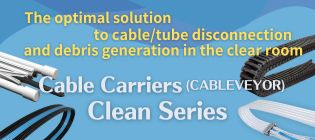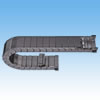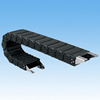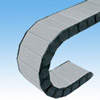Product Info Cable Carriers (CABLEVEYOR)
Cableveyors (cable carriers) are mechanical element components to protect cables/tubes for power or signal from wear and breakage by securely supporting and guiding them that follow moving parts of equipment.
Cables/tubes are passed through base chain which has a link structure like a chain, and runs freestanding at a constant bending radius between moving end part and the fixed end part.
Depending on the number of cables/tubes stored, installing dividers inside prevent the contents from sliding and extend the service life.
Materials include plastic and steel, and can be used for linear, swivel and 3D movements.
Cable Carriers (CABLEVEYOR) Related information
Structure & Features
- ・Cables/hoses are stored in base chain and are supported and guided in an orderly and securely without applying excessive force.
- ・Bending section bends in only one direction at a fixed radius, protecting cable/hose and maintaining a path.

Glossary of technical terms (Unsupported length / Travel length / Leeway length / Bending radius / Total height / Mounting height / Required space / Leeway space )
Unsupported length (F)
Distance from moving end to peak of bending section. This is length that is self supported.
Allowable length is determined by the model. Check load diagram on each product page.
Travel length (S)
Movement distance between two points where the moving end of cable carrier (moving part of the equipment) completes one cycle.
Leeway length (K)
Leeway length the cable carrier has to absorb any differences in installation dimensions.
Leeway length depends on the model. Check the "Calculating no. of links" item on each product page.
Bending radius (R)
Cable carrier bends in a fixed direction at a constant radius. This radius is referred to as the bending radius.
Bending radius depends on each model. Check each product page.
Allowable load graphs
Load diagram shows the allowable range of unsupported length and travel length for cable/hose mass (kg/m). Cable carrier can be used if the operating conditions fall within the range of dashed lines.
Load diagram depends on the model. Check the load diagram on each product page when selecting products.
Total height (H)/Mounting height (H')
- ・Total height (H):Height from the outside surface of fixed end bracket to the peak of bending section (outside).
- ・Mounting height (H’):Height from the outside surface of fixed end bracket to the outside surface of moving end bracket.
To compensate for sag in a unsupported length section caused by cable carrier's weight and cable/hose mass, cable carrier has a structure given pretension.
If cable carrier is installed at a total height, pretension will be constrained and an excessive force will act on cable carrier. This may reduce service life of cable carrier, so always use a mounting height when designing an equipment and installing cable carrier.
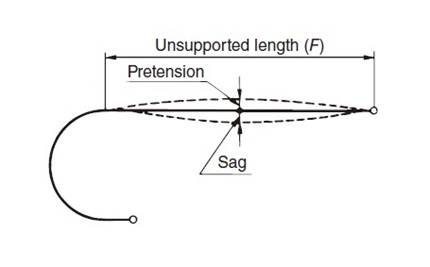
※Note: Mounting height is not "the height from the fixed end bracket installation surface to the moving end bracket installation surface". (Refer to the diagram below. )
When using brackets for inside mounting, please design and install them with "the height from the outside surface of fixed end bracket to the outside surface of moving end bracket" as the mounting height.

Required space (h)/Leeway space (S)
Required space (h) is a space required to install cable carrier in an equipment.
Include a leeway space (S) to prevent cable carrier from hitting an equipment due to pretension, chordal action, and flopping during movement. Check calculation method in the catalog.

Note) Design and install according to the mounting height H' dimension.
Explanation of Structure (Base chain / Mounting bracket / Divider )
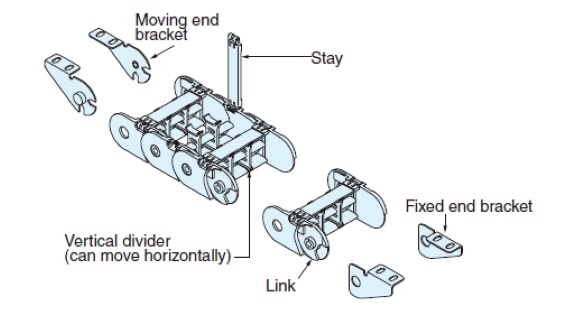
Cable carrier base chain
The cable carrier body is composed of links and stays and is the part that installs cables/hoses.
It has a function where it bends in one direction only at a constant radius. There are different types of openable stay structures, and these include the outside openable stay and inside openable stay.
Outside

Inside
For the type that opens both to the inside and outside, the inside stay is called a lock stay.
Bracket /Mounting brackets/steel brackets
These are parts for mounting the cable carrier on the equipment. Plastic parts are called brackets and metal parts are called steel brackets.
There are various types depending on the structure and mounting method. The applicable types depend on each cable carrier. Check the product pages for further information.
Divider
Dividers are parts that divide up the installing space inside the cable carrier.
- ・Vertical divider :Horizontally divide the installing space inside the cable carrier. There are sliding types and fixed types. Dividers are normally installed every 2 links.
- ・Horizontal divider :Vertically divide the installing space inside the cable carrier. There are types that divide the entire space and types that divide part of the space.
2 or more vertical dividers are required when using a horizontal divider. - ・The lineup of dividers depends on each cable carrier model. Check the product pages for further information.
Cableveyor/Cable Carrier Product List
- Plastic Series
open type - Plastic Series
closed type - Clean series
- Plastic Series
3D - Steel Series
open type - Steel Series
heavy duty - Cable carrier
/Accessory - TOTALTRAX
Cable carrier base chain is made of plastic and cables/hoses that go inside are not visible.
Fully closed structure protects cables/hoses from dust.
When purchasing this product outside of Japan, please contact nearest overseas office using the link below.
TKC Series
Model No. TKC□□H□□~
Standard closed type cable carrier.
- ・Fully closed structure protects cables/hoses from dust and spatter.
- ・Gliding arrangement, circular travel arrangement and a wide range of other special series are available.
- ・RoHS Compliant Product
TKA Series
Model No. TKA□□H□□~
Highly sealed cable carrier.
- ・Protects cables/hoses with a sealed structure that prevents dust and spatter from entering from the outside.
- ・Lighter, space-saving and longer unsupported length than other closed types.
- ・RoHS Compliant Product
TKMT Series
Model No. TKMT□□H□□~
Cable carrier with higher rigidity and more functions than TKC series.
- ・Fully closed structure protects cables/hoses from dust and spatter.
- ・Easy to cut/connect and adjust length.
- ・RoHS Compliant Product
TKXT Series
Model No. TKXT□□□H□□□~
Closed type cable carrier with the highest cross-sectional height inside the link.
- ・Installation space can be used efficiently thanks to wide range of inner width sizes.
- ・High inner height allows for a large storage space.
- ・RoHS Compliant Product


